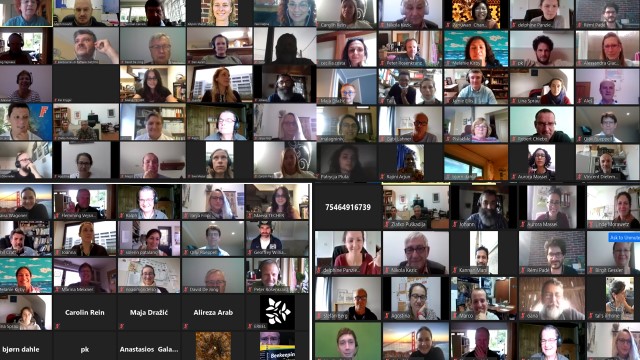Photo: Varroa Control workshop at Annual Coloss meeting 2020 via Zoom
Varroa control

ABOUT
The Varroa mite is one of the main challenges of today’s beekeeping almost worldwide due to its direct damages and those caused by the viruses it vectors.
This Task Force of COLOSS is composed of Varroa destructor researchers, bee health experts, and extension workers. Current members include about 80 researchers from more than 20 countries.
PURPOSE
Task force members focus on developing and encouraging sustainable solutions for management of the ectoparasitic mite V. destructor, one of the most devastating threats to honey bees. The philosophy of the group is the adoption of Integrated Pest Management schemes (IPM).
The group’s specific aims are to:
- Evaluate beekeeper’s practices against Varroa on efficacy and safety for honey bee populations and products (with Monitoring group)
- Improve current management options and to develop novel strategies
- Evaluate diagnostic methods for Varroa infestation levels
- assess the impact of infestation levels on colony survival and productivity
- Develop new reserch tools
- Explore mechanisms of Varroatolerance and resistance in different honey bee populations (with Bee Breeding and Survivor Task Force)
- Provide recommendations for sustainable destructor management to beekeepers (with B-RAP CP).
RESEARCH OUTCOMES
One of the activities of the Task Force has been published in 2021 in Applied Sciences. The article reports on the evaluation of two different methods to estimate the varroa infestation level. The experiment involved 151 honey bee colonies in nine apiaries of four countries (Algeria, Croatia, Italy, Poland). After the main honey flow, we compared the 10-day natural mite fall and the powdered sugar roll methods with the varroa population in each colony. According to our results, the powdered sugar roll method could be suggested to beekeepers as a suitable IPM tool for varroa control, while natural mite fall represents a more accurate method that could be adopted for selection/research purposes. For more details, please look for the article (https://doi.org/10.3390/app11104458)
The results of a recent common research were published in 2020 in Journal of Apicultural Research under the title “summer brood interruption as integrated management strategy for effective Varroa control in Europe”. It’s the result of 2 season research in 10 European countries on 370 colonies in which we tested the efficacy of different brood interruption methods (queen caging, different trapping comb techniques and brood removal) on varroa control. Briefly, we report high efficacy of treatment consisting of queen caging followed by 4.2% oxalic acid treatment. Further, biotechnical methods without usage of any chemical treatment did not differ significantly from the queen caging groups. Beside efficacy of different treatments, we tested influence of mentioned methods on colony strength and average workload needed to perform all activities. Several workshops were organised before the start of experiment to ensure that used methods are applied equally on all research sites. For more details, please look for the article. (10.1080/00218839.2020.1793278)
ONGOING ACTIVITIES
- CSI Varroa – Citizen Scientist Initiative for Varroa damage thresholds (Fani Hatjina, Janja Filipi, Nikola Kezić). (Protocol)
- Impact of brood interruption on the colony productivity (Marin Kovačić, Aleksandar Uzunov). (Protocol)
- Varroa in vitro rearing – (Cameron Jack & Delphine Panzera)
- Dissemination and Varroa book preparation (Victoria Soroker, Flemming Vejsnæs, Norman Carreck)
PLANNED ACTIVITIES
- Monitoring Varroa resistance to synthetic acaricides in around the globe – suggested by Victoria Soroker
CONTACT
Are you interested in joining this COLOSS task force?
If so, please contact one of the task force co-chairs below.













